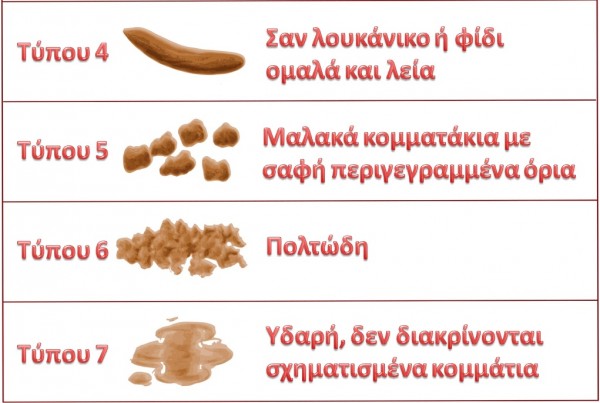What is the poop chart?
The poop chart, formally known as the Bristol Stool Scale, was developed by Dr. Ken Heaton at the University of Bristol in 1997. It categorizes stool into seven types based on their appearance and texture. This scale is widely used by healthcare professionals to assess digestive health and diagnose conditions such as irritable bowel syndrome (IBS), constipation, and diarrhea.
The seven types of stool on the Bristol Stool Scale are:
- Type 1: Separate hard lumps, like nuts (hard to pass)
- Type 2: Sausage-shaped but lumpy
- Type 3: Like a sausage but with cracks on the surface
- Type 4: Like a sausage or snake, smooth and soft
- Type 5: Soft blobs with clear-cut edges (easy to pass)
- Type 6: Fluffy pieces with ragged edges, a mushy stool
- Type 7: Watery, no solid pieces (entirely liquid)
Types 1 and 2 indicate constipation, Types 3 and 4 are considered ideal, and Types 5, 6, and 7 suggest diarrhea or increased bowel urgency.
Why is the poop chart important?
Your poop is a reflection of your digestive system’s health. By monitoring its appearance, you can identify potential issues early and make necessary lifestyle or dietary changes. Here’s why the poop chart matters:
- Early Detection of Digestive Issues: Changes in stool consistency or frequency can signal conditions like IBS, Crohn’s disease, or food intolerances.
- Hydration and Diet Assessment: The chart helps you understand how your diet and hydration levels affect your digestion.
- Tracking Progress: If you’re making dietary changes or treating a digestive condition, the chart can help you monitor improvements.
- Communication with Gastroenterologists: The chart provides a standardized way to describe your stool, making it easier to discuss symptoms with your gastroenterologist.
What does each type mean?
Let’s break down the seven types of stool and what they indicate about your health:
Type 1: Separate hard lumps
- Appearance: Small, hard, and difficult to pass.
- Indication: Severe constipation. This type suggests a lack of fiber and water in your diet.
- Action: Increase fiber intake (fruits, vegetables, whole grains) and drink more water.
Type 2: Sausage-shaped but lumpy
- Appearance: Log-shaped but lumpy.
- Indication: Mild constipation. This type may also indicate slower transit time in the colon.
- Action: Add more fiber and fluids to your diet, and consider light exercise to stimulate bowel movements.
Type 3: Sausage-shaped with cracks
- Appearance: Log-shaped with slight cracks on the surface.
- Indication: Normal stool. This is a sign of healthy digestion.
- Action: Maintain your current diet and lifestyle.
Type 4: Smooth and soft sausage
- Appearance: Smooth, soft, and easy to pass.
- Indication: Ideal stool. This type suggests a well-balanced diet and good digestive health.
- Action: Keep doing what you’re doing!
Type 5: Soft blobs with clear edges
- Appearance: Soft blobs that are easy to pass.
- Indication: Mild diarrhea or a lack of fiber.
- Action: Monitor your diet and ensure you’re consuming enough fiber.
Type 6: Fluffy pieces with ragged edges
- Appearance: Mushy and irregular.
- Indication: Mild to moderate diarrhea. This type may indicate inflammation or infection.
- Action: Stay hydrated and consider consulting a doctor if symptoms persist.
Type 7: Watery, no solid pieces
- Appearance: Entirely liquid.
- Indication: Severe diarrhea. This type suggests an infection, food poisoning, or a digestive disorder.
- Action: Seek medical attention if diarrhea lasts more than 48 hours or is accompanied by dehydration, fever, or pain.
Factors that affect stool appearance
Several factors can influence the appearance and consistency of your stool:
- Diet: Fiber-rich foods promote healthy bowel movements, while processed foods can lead to constipation or diarrhea.
- Hydration: Adequate water intake is essential for soft, easy-to-pass stool.
- Exercise: Physical activity stimulates digestion and helps maintain regularity.
- Stress: High stress levels can disrupt your digestive system, leading to changes in stool consistency.
- Medications: Certain medications, such as antibiotics or iron supplements, can affect bowel movements.
- Medical Conditions: Conditions like IBS, Crohn’s disease, and celiac disease can alter stool appearance.
When to see a doctor
While occasional changes in stool are normal, persistent abnormalities may require medical attention. Consult a healthcare provider if you experience:
- Blood in your stool
- Black or tarry stool (indicating possible internal bleeding)
- Persistent diarrhea or constipation
- Severe abdominal pain
- Unexplained weight loss
- Changes in stool color (e.g., pale or clay-colored stool, which may indicate liver or gallbladder issues)
Tips for maintaining healthy stool
- Eat a Balanced Diet: Include plenty of fiber from fruits, vegetables, and whole grains.
- Stay Hydrated: Drink at least 8 glasses of water daily.
- Exercise Regularly: Aim for 30 minutes of moderate exercise most days of the week.
- Manage Stress: Practice relaxation techniques like yoga or meditation.
- Listen to Your Body: Don’t ignore the urge to have a bowel movement.
Conclusion
The Bristol Stool Chart serves as a useful guide for monitoring bowel health and identifying potential issues. Occasional variations in stool types can be normal, but persistent changes or the presence of symptoms like pain, blood, or mucus in the stool should prompt medical consultation. Diet, hydration, and lifestyle adjustments can often help manage and improve bowel health, but underlying health conditions should be addressed by gastroenterologists.


